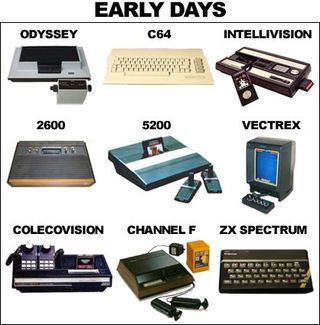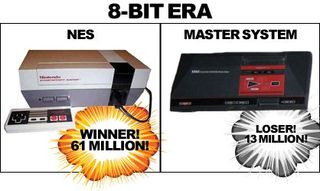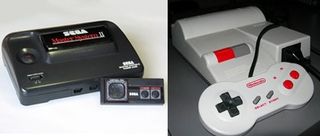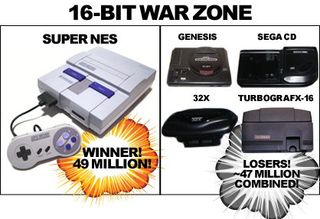If digg, N4G and NeoGaf are any indication, the internet was invented solely for gaming Neanderthals to argue about the console wars. "Framerate" this, "exclusive game" that. "Pixel bump shader fliter proxy triple mipmapping" this, "physics porn" that. It's really quite tiring, isn't it? What if we told you there was a clear and easy way to predict each victor with 90% accuracy - a way to forever silence the incessant forum-vomiting that is The Console War?
Well, we can't make them quit babbling about 720p and backwards compatibility, but we can offer this observation to those who're willing to sit back and look at the big picture - the white console always wins. Every time, white or grey demolishes the opponent, who's usually draped in black. Maybe it's a light/dark subliminal suggestion, we're not sure, but with only one major exception the black console is handed its ass. Obviously we're not saying black plastic is the reason these machines lost... it's just a pretty damn startling coincidence.
Note: Before we even get into this, we'll openly acknowledge the obvious complaints we'll receive over elevating something "white" over something "black." To this, we say A: Grow up, B: Numbers don't lie and C: Some of our favorite consoles are black

Yes you young'uns, there were consoles before PlayStation, and most of the victors were black, not white. Seems totally contradictory to our point, no? Well get a load of this nugget of blinding semi-truth: after the big industry crash of 1983, all consoles that went on to major success and eventual "victories" over their rivals were either white or grey, save one. We're not saying the color of the Atari 2600/5200, Vectrex, Intellivision or Colecovision led to the end of an entire industry, but it's hard to ignore the fact that hardware companies then tried their best to distance themselves from their cast-out ebony relatives. And yes, Atari had all kinds of random junk out that was white and grey, but that brand was so untrustworthy we doubt lining them with gold would have helped.
Atari's most popular console, the 2600, was indeed black and fended off whiteys like Commodore 64, but it's also directly blamed for the crash that killed the hobby. It also featured a wood paneling frame - thanks, '70s!

Here's where the very idea of a true console war got its start, with two systems of opposing colors duking it out for weary buyers' attention. We all know how this one turned out - the NES annihilated Sega's Master System on all fronts. Europe saw a more level battleground than Japan or North America, but for all intents and purposes, the light-colored console walked away victorious, confident and, in Nintendo's case, a little too arrogant.

1990 and 1993 saw re-imagined, slightly tweaked versions of the SMS and NES. Both kept their color scheme and died quietly, mainly due to the overwhelming bitchfest that was going on in the brand-new 16-bit world, a fervor that hasn't been replicated since.

Round 2 between Nintendo and Sega rocked the gaming world like never before. You think flame-baiting trolls are bad? Try full-on fistfights, in public, face-to-face with other people, over something as simple as"Genesis Does What Nintendon't."We didn't hide behind fake avatars or create joke accounts to hide our true identity, we got up in each other's faces and literally fought a console war. But in the end, the ashy white Super NES emerged with triumphant battle scars and a solid lead into the next generation. Oh, and all of Sega's junky add-ons met quick ends too, and marked the beginning of the company's baffling policy of putting out new machines at the worst possible times.
The TurboGrafx-16 and TurboDuo also came and went in this time period, the former translated into a handheld that also met its end at Nintendo's next machine.
